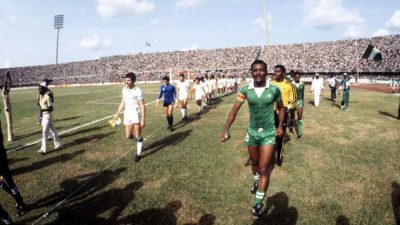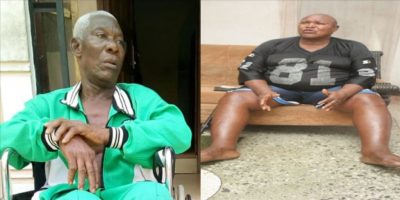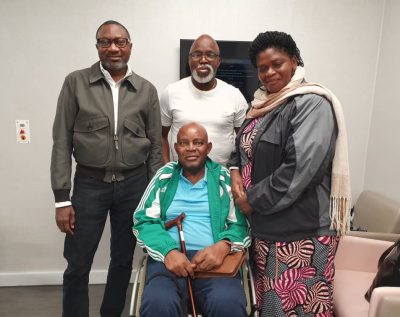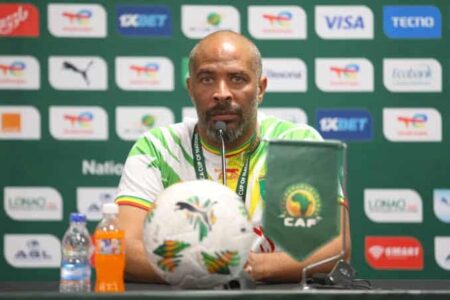By Steve Austin Nwabueze
This article is the first part of a two – part paper articulating the legal issues arising from the plight of ex-Nigerian footballers, some of whom have been known to battle one ailment or the other from their playing days.
INTRODUCTION
Time and again, the theory that the allure of a lucrative and glittering club profile is sufficient to have a fulfilling footballing career has been debunked by statistics showing that players who were privileged to don their national team jerseys enjoyed more renown in the game than players who just enjoyed a club career only. Eric Cantona, Jean Pierre Papin, Edmundo Alves De Souza Neto (“The Animal”), Andrew Cole, Jonathan Akpoborie, etc. all top the list of elite professional footballers who never made the grade on the international scene. George Opong Weah would happily trade one of the Italian Scuddeti he won with the Rossoneri (AC Milan) for an Africa Cup of Nations trophy with Liberia. For this breed of players, their glittering careers always fall short when their national careers come under searching scrutiny.
It is therefore not surprising that Nigerian footballers have over the years, seen the opportunity of representing their country at various international tournaments and championships (sporting events) as an immense honour. Unfortunately, what once served as a beacon of hope for young and aspiring footballers has become a source of despair for their older counterparts, most of whom are well decorated athletes now languishing in one life threatening ailment or the other. Ex- Nigerian footballers such as Haruna Ilerika, Peter Fregene, Peter Anieke, Teslim Balogun, Willy Bazuaye, Anthony Igwe, Augustine Ofuokwu, Samuel Okoye, Segun Olumodeji, Samuel Opone, Oshode Muyiwa, and Paul Hamilton, the “Mathematical” Segun Odegbami, Adokiye Amiesimaka, Christian Chukwu, amongst many others, were players who made tremendous impact for their country and respective clubs in their careers.
Same for Kenneth Olayombo, Mohammed Lawal, Durojaiye Adigun, Willy Andrews, Sebastian Broderick-Imasuen, Clement Obojemene, Ganiyu Salami, Fred Aryee, Joseph Aghoghovbia, Yakubu Ibrahim, Yakubu Mambo, Alfred Kossi, Bunmi Adigun, Emmanuel Okala, Stanley Okoronkwo, and Christian Madu.

THE CONUNDRUM
Today, none of these ex-internationals has retired ‘happily’ in the true sense. It has been successive tales of woe involving one ex-international or the other. Advanced in age, they are living in deteriorating health and extremely poor economic state. Some have died in abject squalor and unsung while those of them still lucky to be alive either live in obscurity or forgotten; only remembered as part of the ‘relics’ of our footballing history. Yet in their heyday, these were shining stars, blessed with special talents. Many of these ex footballers suffer from muscular injuries that date back to their playing days. It is pertinent to point out that unlike the current league structure with twenty teams (before the two tier structure currently in place by the LMC), the Nigerian Professional League dates back to 1972 with Rangers International of Enugu, IICC Shooting Stars of Ibadan, Racca Rovers, Mighty Jets of Jos, Bendel Insurance of Benin and Stationery Stores of Lagos. Accordingly, the fixture list of the national League was relatively manageable. On the other hand, national assignments were more frequent as the national team was always engaged in one competition or the other; from the WAFU Cup, All Africa Games, Nations Cup, qualifiers for these major tournaments and a host of other competitions. It is little wonder then why a lot of the ex-internationals donned the national colours with pride since that was the only guaranteed way of seeking greener pastures abroad.
The Role of the Football Federation and the Federal Government
In preparation for and during these sporting events, the Federal Government of Nigeria, through the relevant sporting federations invite the selected athletes/footballers for these events in line with FIFA regulations.
The Federal Government employs and seconds medical staff (doctors, nurses, physiotherapists, etc.) and assigns these medical practitioners to the various national teams.
These medical staff provide treatment for sporting injuries that occur during the course of executing national assignments like the World Cup, the Olympics, the Africa Cup of Nations, qualifiers for major international events etc. The staff also certify to the athlete/footballer and to the relevant national team that the athlete has fully recovered from his/her injuries and “is fit to play”.
This article analyses the discernible legal issues arising from the plight of these ex- internationals and the possible redress open to them. The following paragraphs discuss in extenso, the possible cause of action in clinical negligence against the Federal Government and its agents.
For brevity, this article comes in two broad parts. Part 1 of the Article focuses on the analysis of the legal issues underpinning the ex-players’ situation. Part 2 rounds off the analysis and highlights the procedural challenges such a proposed move may face.
Football Injuries – What the Numbers Say
The incidence of outdoor football injuries is among the highest of all sports, particularly for adult male players. Research has shown that an elite football team with 25 players in the squad can expect about 18 injuries each season. Half of the injuries will be minor, causing absences of less than a week but as many as eight or nine will be severe injuries causing absences of more than four weeks. The incidence has been described to be around 24.6 and 34.8 per 1,000 match hours, and 5.8 to 7.6 per 1,000 training hours .
The demands placed upon professional players are growing because of the increased fixture schedule, resulting in less recovery periods between training and competitive match play. This increases the risk of injury .
It has been suggested that recovery time between two matches, 72 to 96 hours, appears sufficient to maintain the level of physical performance but is not long enough to maintain a low injury rate.
Also Read – Siasia And Integrity of Football: Application of Deterrence Theory of Criminal Jurisprudence Taken Too Far?
During periods when the schedule is particularly congested (i.e., two matches per week over several weeks), the recovery time allowed between two successive matches lasts 3–4 days, which may be insufficient to restore homeostasis within players. As a result, players may experience acute and chronic fatigue potentially leading to underperformance and/or injury .
It is now reported that the injury rate increases according to hours of football exposure. However, the risk of injury is significantly increased when games overlap training with less than 72 hours between them. In this circumstance where the recovery period is under 72 hours, it is necessary to emphasize optimal nutritional recovery strategies .
Unlike club football that accommodates a weekly schedule of matches except in unusual and exceptional circumstances when there is a fixture congestion, national team sports usually played within a space of two to three days during major international or continental tournaments; hence, shorter recovery time accounts for some of these muscular injuries.

THE LEGAL ISSUES – A POTENTIAL CLAIM FOR THE TORT OF CLINICAL NEGLIGENCE
Seeking redress for health-related issues that arise, or is suspected to arise, from sports injuries falls within the ambit of the tort of negligence in law. Negligence is simply a breach of a duty of care by the tortfeasor (the party that breaches a duty of care to the victim) which ultimately results in injury or detriment to the victim. In other words, negligence will be deemed to be established where the claimant is able to establish the following three essential ingredients by evidence:
a. There is a duty of care owed to him by the tortfeasor
b. There is a breach of the duty of care by the tortfeasor
c. Damages or injuries arise from the breach.
A. Duty of Care
Duty of care is the obligation the law imposes on a person to reasonably anticipate or foresee the impact of his action or lack thereof on others, and to take reasonable precaution to ensure that such action or inaction does not cause injury on others. The law of torts has evolved the neighborhood principle to establish the class of persons who may owe a duty of care to others. The foreseeability of the impact of an action is what usually determines who a neighbor is and whether there is a duty to that neighbor.
In contact sports, such as football or rugby, all participants owe a duty of care to one another. In order to show a breach of that duty, conduct must be reckless and fall below the standard required of a reasonably skillful and competent professional player. It must be an act that is more serious than an error of judgement. Thereafter, the injury suffered must be foreseeable. For example, it must be the type of injury that one would expect from a foul or tackle. Given that, the test for negligence in the sporting world is a high threshold to meet.
In sports, it is not always the assailant who is open to be sued – players, clubs, governing bodies and referees can also find themselves subject to legal actions, which will be explored in the case law discussed.
In sport injury cases as it is in other general torts, it is the duty of the claimant to prove that the accused tortfeasor owed him (the claimant) a duty of care. Establishing a duty of care therefore involves stating clearly the party that owed the duty, and the nature of duty that party owed. The athlete/player may be able to establish that the sport administrator or employer owes the duty of care. In certain instances, the organizers of a sporting event or the official of the sport contest may be liable for any negligence that results in the injury to the player.
The Ambit of an “Employer’s” Duty of Care to the Footballer
Clinical researches over the years have thankfully established a guide for the purposes of gauging the ambit of the duty an employer of footballers is expected to discharge. Although the actual breadth of such duty of care varies from case to case, the miniscule obligation imposed on them are as follows:
a. Conducting risk audits: A study of the English Football Association shows that the overall risk exposure of professional players is 1000 times higher than industrial occupations. This clearly demonstrates high risk of footballing, which imposes a higher responsibility on a club and national football governing bodies to mitigate as practicable as possible. This will ordinarily include a routine obligation of the sport administrator to continually inspect the risk exposure of each player in their respective teams to determine whether their participation in the sports will not result in an injury or damage, whether in the immediate or future times. Failure of the sports administrators to conduct these audits may establish their failure to take reasonable care expected of them in the welfare of players.
b. Implementing risk management policy and procedure to minimize risks: Conducting risk audit on members of the team should ordinarily have led to recommendations which will form the basis of the policies that will minimize risks or manage them. For instance, the teams would have standard procedures for the length of time an injured player will be expected to return to training and the procedure for approval from qualified medical and fitness experts before a player is expected to return to training.
c. Appointing competent persons to maintain supervision of the team: It should also be the duty of sports administrators to ensure that the medical team of the football team are qualified and provided with adequate equipment that will assist them diagnose and treat injuries that may have short- and long-term dire effects.
d. Maintained facilities at expected standards: The above highlighted factors also include the duty on the sports administrators to ensure that players are not exposed to training facilities that may induce, cause or worsen injuries.
e. Maintain insurance policies to cover injury exposure risks.
The above-highlighted factors could form a yardstick with which a claim can be made against sports administrators in Nigeria for negligence.
Applying the foregoing to the pith of this article, one wonders how often the Nigerian football administrators conducted those risk audits and how much of their findings were implemented in the course of prosecuting national assignments. What is the current state of the risk management policy of the Glass house and how much has it impacted the periodic risk audits (if any) of the Nigerian Football Federation? How often are the training facilities used by the players audited to ascertain their level of involvement (if any) on the injuries sustained by the players in the course of prosecuting national assignments?
Unfortunately, the writer cannot hazard a guess of the answers to these posers. It suffices to say therefore that available materials are insufficient in themselves to ascertain the depth of the knowledge of Nigeria’s football administrators regarding some of these issues.

B. Breach of Duty – A Peep into Some Judicial Decisions on the Point
In addition to establishing a duty of care, the claimant will be expected to show that the medical professionals who attended to the injured player at the time of playing for the national team and/or their respective clubs owed a duty of care to the injured player which they failed to discharge. It must also be demonstrated that the medical personnel of the team were reckless in the discharge of their duties than their counterpart in the same field. In Bolam v Friern Hospital Management Committee the court restated the common law position on clinical negligence which states that the claimant must show that the practitioner has not acted in accordance with a practice accepted as proper by a responsible body of medical men skilled in that particular area. To prove this, a medical expert would be required to ground medical negligence.
In Collett v Smith, an English case, the claimant, a young Manchester United player, in a game against Middlesborough, was injured by a Middlesborough player. That injury led to a brain damage which made him permanently incapacitated. He brought an action against the player and Middlesborough. The court held that Middlesborough was vicariously liable for the damage caused by the negligence of its player.
To establish a case of vicarious liability, a relationship between the medical practitioners whose negligence caused the damage and the National Sports Commission under the Ministry of Youths and Sports (MYS) must be established. This will be shown by proving to the court that the medical practitioners carried out the directives to handle the health care of the players on the instructions of the National Sports Commission and the Ministry of Youth and Sports. Put differently, the medical practitioners, who are not independent contractors, carried out their actions as servants of the NFF and Ministry of Youth & Sports. This position would hold sway in view of the court of Appeal’s position in Gata V. Paulosa Nigeria Ltd..
C. Injuries from the Negligence
A clear injury that arises from a negligent act will entitle a claimant to reliefs in damages. However, to establish that there is an injury, the law is settled that the claimant must establish a causal link between the alleged negligent act of the tortfeasor and the injury sustained by the claimant. In other words, a reasonable person must be able to deduce that the act of the tortfeasor causes the injury of the victim/claimant. To ensure that lag of time does not make evidence admissible to prove a case in negligence stale or too old, the law places a restriction of a number of years for the claimant to institute its case. In most jurisdictions, the claimant must institute its case within three years of the occurrence of the negligent act unless it is a continuing act which time will begin to run at the end of the last act.
Disclaimer: The present article reflects only some personal views and general remarks drawn from a legal analysis of the plight of ex- Nigerian footballers and should not be regarded as a legal advice or bind the author in any way. The author confirms he has no professional involvement in this particular matter, whether past or present.
Copyright notice
This work was written for and published on www.completesports.com. (unless otherwise stated) and the copyright is owned by the author. Permission to make digital or hard copies of this work (or part, or abstracts, of it) for personal use provided copies are not made or distributed for profit or commercial advantage, and provided that all copies bear this notice and full citation on the first page (which should include the URL, (www.completesports.com) article title, author name, date of the publication and date of use) of any copies made. Copyright for components of this work owned by parties other than the author must also be honoured.
Email- [email protected].
Telephone – +234-08032336584, +234-08138251803.
__________________________________________
References
Ekstrand, J., Hägglund M. and M. Waldén (2011a). Injury incidence and injury patterns in professional football: the UEFA injury study. Br J Sports Med. 45(7):553-8.
Dellal A., Chamari, K. and A. Owen (2013). How and When to Use an Injury Prevention Intervention in Soccer, Muscle Injuries in Sport Medicine, Prof. Gian Nicola Bisciotti (Ed.), ISBN: 978-953-51-1198-6.
Dupont, G., Nedelec, M., McCall, A., McCormack, D., Berthoin, S., & U. Wisløff (2010). Effect of 2 soccer matches in a week on physical performance and injury rate. The American Journal of Sports Medicine, 38(9), 1752–1758.
Nédélec, M., McCall, A., Carling, C., Legall, F., Berthoin, S. and G. Dupont (2012). Recovery in soccer: part I – post-match fatigue and time course of recovery. Sports Med 42(12): 997-1015.
Dupont, G., Nedelec, M., McCall, A., McCormack, D., Berthoin, S., & U. Wisløff (2010). Effect of 2 soccer matches in a week on physical performance and injury rate. The American Journal of Sports Medicine, 38(9), 1752–1758.
In the famous case of Donoghue v Stevenson [1932] AC 562 , the law defines what is meant by ‘duty of care’ in the dictum of Lord Atkins: “There must be, and is, some general conception of relations giving rise to a duty of care, of which the particular cases found in the books are but instances. … The rule that you are to love your neighbour becomes in law you must not injure your neighbour; and the lawyer’s question: Who is my neighbour? receives a restricted reply. You must take reasonable care to avoid acts or omissions which you can reasonably foresee would be likely to injure your neighbour. Who, then, in law, is my neighbour? The answer seems to be – persons who are so closely and directly affected by my act that I ought reasonably to have them in contemplation as being so affected when I am directing my mind to the acts or omissions that are called in question.
See Majrowski v Guy’s and St Thomas NHS Trust where the employer was held to be vicariously liable.
Watson v British Boxing Board of Control [2001] QB 1134 where the BBBC was held liable for injury of Watson in a boxing match supervised by the British Boxing Board of Control (BBBofC or BBBC), which was expected to provide medical care but failed to adequately provide same.
See Hawkins RD, Hulse MA, Wilkinson The Association football medical research programme: an audit of injuries in professional football Br J Sports Med 2001, 35, 43-47. The article makes the following recommendation: “Professional football players are exposed to a high risk of injury and there is a need to investigate ways of reducing this risk. Areas that warrant attention include the training programmes implemented by clubs during various stages of the season, the factors contributing to the pattern of injuries during matches with respect to time, and the rehabilitation protocols employed by clubs.”
Lagos State Government recently realized the need to insure its players under the Insurance Company of the Government. The government stated shortly before its player left for the National Sports Festival that: “We have insured all our athletes and accompanying officials and paid the required premium to the state owned insurance company, LASACO.” Read more at:
https://www.vanguardngr.com/2018/11/lagos-insures-300-athletes-for-national-sports-festival/
[1957] 1 WLR 582
Nigerian Footballers Abroad (1998) LPELR-5544(CA) The Court held that: “Vicarious liability can arise where the person who was alleged to have committed the offence or the tortious liability is an agent or servant of the person or party to be vicariously liable. In other words, there must be some proof of relationship or connection between them to establish such liability’’
Got what it Takes?
Predict and Win Millions Now








